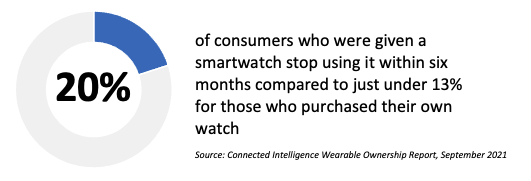
AT&T and Navigil keep tabs on the aged
AT&T has partnered with Finnish-based Navigil, launching a smart/wellness watch aimed at the over 65 year olds. The Navigil 580 watch, which uses LTE, is a kind of monitoring system that caregivers can provide to older family members to keep tabs on them. It tracks all the usual health features – body temperature, heart rate, sleep cycles – as well as allowing the caregiver to set up “safe zones” and if the wearer steps beyond those zones, they get an alert that their aged family member is wandering just a little too far for comfort. The watch also provides voice calls, so you can reach out to check in with the aged relative if you do see they are wandering too far from home. The good news is that the watch looks like a traditional analog watch as the monitoring features are more designed for the caregiver rather than on-device tracking.
The NPD Take:
- AT&T, in particular, has long focused on solutions in the health and wellness sector, particularly those focused on our older relatives. As such, this latest announcement is an incremental step in a long journey.
- But… no one wants to be monitored, especially parents by their children. As such, there are two answers to whether this will succeed: will the younger generation think it’s a good idea and buy them – quite possibly. Will the parents wear them, and continue to wear them once the battery needs charging? Far less likely.
T-Mobile offers free smartwatches
T-Mobile has two new smartwatches that it is offering for free, as long as you add an eligible smartwatch line (which looks to be a 24-month agreement). The two watches are SyncUP KIDS Watch, aimed at the younger audience, and the Timex Family Connect Senior. Unlike the AT&T approach, T-Mobile’s senior solution is aimed at providing information to the senior themselves, but also has the ability to share location, provide SOS calling (and two-way calling) and, of course, the usual mix of health and fitness monitoring.
The NPD Take:
- This is a significant step for a carrier and one we’ve been long expecting: provide the smartwatch for free and make the money back on the long-term connection. We expect that this should drive additional consumers to the smartwatch world, and to T-Mobile specifically.
- Customers hesitant to sign up for a 24-month connection term can choose to pay for the watch either up-front or via an Equipment Installation Plan. But we expect the free device to be the compelling driver for many consumers, especially in the run-up to the holiday season.
Apple in your eye
Apple has been granted a patent relating to smart glasses (or a VR headset) that uses a direct retinal projector system. Such a solution avoids issues relating to depth perception that are (somewhat) common with current solutions, where the brain is confused about the distance to the project image. That, in turn, can cause nausea, eyestrain and headaches. Of course, it’s still a long distance from a patent to a finished product, but the patent does demonstrate Apple’s continued persistence in the area of VR/AR as the next big tech development.
The NPD Take:
- Virtual reality, the metaverse, augmented reality… these are all converging as the next potential leap forward in tech. Of course, in the case of virtual reality, that has been the case for more than 25 years, but we are certainly moving closer to some interesting products. Don’t expect that breakthrough to happen too soon though!
Meta watch?
Meta, formerly known as Facebook, looks set to launch a smartwatch with a camera built in. According to an image published by Bloomberg (discovered by app developer Steve Moser), the watch will be square(ish) with rounded corners, and with a camera notch at the bottom of the screen. Interestingly, Mr. Moser found the image inside Meta’s app that controls its Ray-Ban Stories AR sunglasses, suggesting that there will be a tie in between the two devices.
The NPD Take:
- Combined with previous rumors that the Meta watch could include cellular connectivity, there is the possibility that Meta is planning for a world that doesn’t necessarily require a smartphone, allowing the glasses to link into the watch’s cellular connectivity. That would be, to put it mildly, interesting. The company formerly known as Facebook tried to enter the smartphone market once upon a time, but was too late to make an impact. Looks like the company plans to stay well ahead of the curve this time around.
- The camera is a somewhat unique addition to the smartwatch. Yes, early smartwatches included cameras (such as Samsung’s original Galaxy Gear) but this functionality quickly dropped out of mainstream smartwatches as more emphasis was placed on health and wellness. But considering Meta’s focus on social media and (of course) the future Metaverse, we should expect pretty much every device they launch to include a camera from now on.


